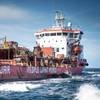In a move that will set in motion the next phase
of its Expansion Program, the Panama Canal Authority (ACP) has released its request for
proposal (RFP) for the Canal’s Pacific entrance dredging. Different from the dry excavation, this
project will deepen and widen the Canal’s Pacific entrance channel to ensure that longer, wider
ships can reach the new locks.
The document is available at: http://www.pancanal.com/eng/procsales/buy.html
The scope of work will include the dredging of approximately 9.1 million cubic meters (321 cubic
ft.) and will widen the 8.9 mile-long navigation channels at least 218 meters, deepening them to a
maximum level of -15.5 meters Mean Low Water Springs (MLWS).
“The Pacific entrance dredging is integral to expansion and the construction of the new lane. The
Pacific side’s geological characteristics make it more challenging than the Atlantic side. We will
need a firm with the specialized equipment and experience to meet the demands of the project,”
said ACP Project Administration Division Manager John Langman. “We’re proud that expansion is
moving forward on schedule and we look forward to attracting qualified firms for this next stage.”
Prior to the release of the Pacific entrance dredging RFP, on August 7 the Panamanian National
Environmental Authority (ANAM) approved the environmental impact study (EIS) for the project.
With this approval, the ACP can now move forward with the process to select a firm.
Bids for the Pacific entrance dredging are due January 28, 2008, and important dates in the
process include a site visit September 19 and a discussion meeting September 20. The ACP will
ultimately evaluate proposals that meet the project’s needs based on a combination of best value
and individual consultations with bidding firms.
Expansion will build a new lane of traffic along the Panama Canal through the construction of a
new set of locks, which will double capacity and allow more traffic and longer, wider ships.
Sponsored Content
Chris-Marine’s solutions help to prolong engine lifetime

AST is now AST Networks, bringing you remote connectivity wherever you are

March 2024
 Read the Magazine
Read the Magazine

 Read the Magazine
Read the Magazine
This issue sponsored by:

Inland Waterways Focus: The Pacific Northwest Columbia-Snake River System
March 2024
 Read the Magazine
Read the Magazine

 Read the Magazine
Read the Magazine
This issue sponsored by:

GAO: Coast Guard Should Better Monitor its Efforts to Credential Merchant Mariners
Subscribe for
Maritime Reporter E-News
Maritime Reporter E-News is the maritime industry's largest circulation and most authoritative ENews Service, delivered to your Email five times per week










